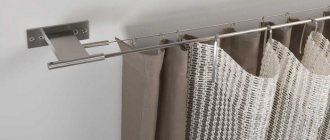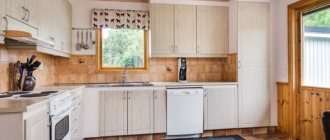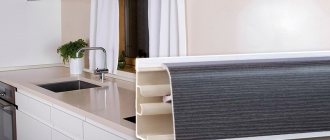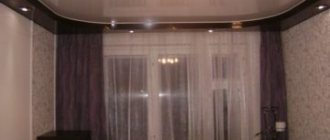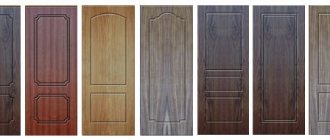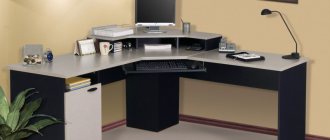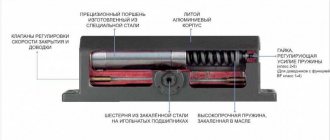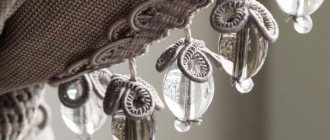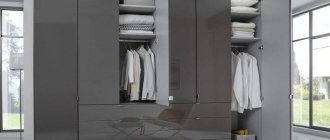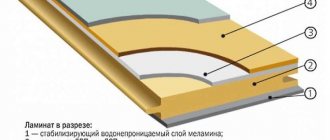In this article I will tell you what a shower drain and shower tray are, and also share my experience in choosing and installing them. If this is your first time on my website, I’ll introduce myself: my name is Evgeniy.
I am an installer of heating, water supply and sewerage systems. I work mainly in private homes; you can get to know me in more detail on the “about the author” page.
A shower drain or tray is a device for collecting water from the floor surface and then discharging it into the sewer. They are called showers because they are often used in showers made using construction methods.
This is when the drain hole is in the floor, the grate is installed flush with the tiles, and the water goes into it when you bathe in the shower.
What is the difference between a ladder and a tray?
In simple terms, a shower drain differs from a tray in size and appearance. A drainage device with a square or round grate is called a drain. A shower tray is a drainage channel with a rectangular grille.
Since the trays have a larger grid area, they also have a larger area for collecting water from the floor. Many people think that if the shower tray is larger than the drain, then the water will flow into it faster. However, this is not quite true. I'll explain why a little later.
Types of designs
Drain ladders are presented in a wide range: models differ in size, shape, hole diameter, and configuration. By design, they are all divided into three types: point, wall and linear.
shower drain
Spot
The point drain is the most compact compared to other types - its size usually does not exceed 15x15 cm. The average throughput is 20-25 liters per minute. The most popular are square and rectangular models, shaped like tiles that can harmoniously fit into the floor covering, but round drains are also available for sale. A distinctive feature of point drains is the ability to install them anywhere in the bathroom, the main thing is to ensure a uniform slope of the floor on all sides towards the drain.
Contents: drain body, upper decorative grille, mechanical water seal, metal mesh
Point drainage ladder
Wall-mounted
This type of drain is the least noticeable, since it is mounted with an outlet into the wall. The grate is located at the junction of the wall and floor and does not disturb the tile pattern. Here the slope should be in one direction towards the grate, the angle of inclination should be about 2 degrees. Wall-mounted models are more expensive than traditional drains, as they have a high throughput capacity - up to 40 liters per minute. Due to the design features, such a drain can only be installed during the initial arrangement of the premises or during a major renovation, although the installation itself has a simple technology.
Geberit Duofix wall-mounted shower drain
Linear
A linear drain with an elongated rectangular shape is also called a drainage channel or shower tray. They differ from traditional models not only in appearance, but also in their design, although they perform the same functions. The water intake part is made in the form of a narrow channel, the length of which varies between 30-120 cm. The structure is closed from above with a decorative grille, and the connection to the sewerage system is made along a horizontal line with a slight slope, which is an ideal option when there is a lack of space in the floor, that is, in apartments
Linear drain 105 cm for tiles 5-7 mm thick
They are mounted along the walls along the width or length of the shower stall; in some cases, installation at the entrance area is allowed. The slope of the floor is provided in one direction - towards the ladder. The main advantage of such models is their high throughput (up to 60 liters per minute) and large water collection area. For this reason, linear drains are the best solution for rain showers and rain showers, where the volume of water supply is quite significant.
Linear ladders have a large capacity
As for the appearance: the narrow decorative grille fits harmoniously into the floor covering and attracts almost no attention. Many manufacturers offer models with special overlays that can be covered with the same tiles or mosaics as the floor, and for drainage there are narrow and almost invisible gaps on both sides of the overlay. The material from which the grilles are made is easy to clean from soap deposits and other contaminants, does not fade or wear off, and retains an attractive appearance throughout its entire service life.
Invisible linear ladder
Which is better: shower drain or tray?
When customers ask me: Zhenya, I want to install a shower drain in the floor, tell me if I should install a tray or a drain? I usually answer them like this: If your shower is built using a construction method or a shower cabin without a tray, then it is best to install a tray.
It costs more, but it also looks beautiful. If you have a shower with a tray, then I recommend installing a drain in the bathroom. It will come in handy if the flexible line bursts and water starts gushing out of it.
When purchasing and selecting a tray or ladder, be sure to ensure that it has a dry seal. Now I will explain what it is and why it is needed.
Advantages of a homemade shower cabin
Many homeowners like the “something between a shower cabin and a “factory cabin” option, which is often found abroad. In the bathroom, parallel to one of the walls, a partition approximately 90 cm long is built, on the fourth side this nook is fenced with a curb 10-15 cm high.
The design is complemented by a beautiful curtain, glass or plastic door. The main financial costs here fall on the shower mechanism.
The advantages of this design:
- You can choose the appropriate sizes yourself;
- You can choose any design: lay out mosaics, make comfortable shelves.
Many people also do this economical option: they put a pallet on bricks and communications under it. Two sides of such an improvised cabin are tiled walls, and two more are purchased sliding doors.
ZulfiyaForumHouse Member
The purchased shower stall has a lot of bells and whistles, they are not used at all, and we did not pay for them. We are going to build a private house, and there we will make an option with a pallet, tiles and sliding doors.
This shower cabin was built by a member of our portal with the nickname Souze. Not a single ready-made shower cabin of adequate cost was suitable for his height of almost two meters, so he made the design with parameters of 900x900x2200.
The most expensive in the list of consumables were plastic panels for 3,000 rubles and a ready-made pallet, purchased for 1,100 rubles. Also needed:
- Four bars 30x40x3000 - 80 rubles per piece.
- Polycarbonate sheet 1000 x 2100 - 700r
- Pipe F16 with flexible pipe and brackets - 200 RUR
- Spray paint - 150 rub.
- Two meters of plastic plinth - 250 rub.
- Sealant, screws, mounting foam, alligator clips with rings - about 500 rub.
Work procedure: First, the rear walls of the cabin were assembled from vertical plastic panels. They are easily attached to each other with grooves and are assembled simply, like a children's construction set. All joints were coated with transparent sealant.
The next step is installing the pallet. A special wooden base was assembled under the pallet, and during installation of the pallet, the master filled all the voids with foam in a spiral, from the edge to the center - this way the pallet will not sag. When the foam swelled and hardened a little, the master simply put the pallet in the place where it should be and left it until the morning. Then I screwed it to the floor.
SouzeForumHouse Member
The only place where it can leak is the siphon. There is a normal hole in the floor for ease of installation and replacement. But I installed everything with sealant, I hope it won’t leak soon.
A wooden frame for a pallet can be lined with polycarbonate from the inside, then all the wood will be outside and will last a long time.
The edges of the plastic baseboard turned out to be rubberized, but for reliability, Souze treated its upper and lower parts with sealant.
The hardest part was making the side walls. To do this, the master sawed the bars into pieces measuring 400mm (wall length) x 2003mm (cabin height minus the height of the pallet with the frame). On two long bars (2003 mm) from below, I cut out the profile of a plastic plinth with a jigsaw: this way they can fit snugly both to the pallet and to the plastic wall.
In the bars (on the thirty-centimeter side) he made grooves 1 cm deep and the width of a polycarbonate sheet (6 mm).
SouzeForumHouse Member
The groove needs to be made larger to leave a gap, this makes subsequent installation easier.
The bars were attached like this: first those in which the profile for the baseboard was cut (with three screws), then the bottom bar, then the top one. The screws for the two lower bars were perfectly screwed into the holes made in the pallet with a F2mm metal drill.
The polycarbonate was cut to size, adding 1 cm to each side (to the depth of the groove).
I secured the structure of six bars with polycarbonate with the last two bars so that they would not burst when tightening the screws; for each hole I made a pocket with a drill, about 1 cm deep and with a diameter slightly larger than the nail head.
I painted the bent pipe, installed it, and then sealed all the joints in the polycarbonate walls with sealant and hung the curtain.
Technical device
The design of the drain resembles a glass, in the lower part of which a pipe is welded, which is connected to the sewerage system. The tray, as you may have guessed from the name, has a design reminiscent of a rectangular container. And also at the bottom there is an exit for connection to the sewer pipe.
There are 2 types of outputs: vertical and horizontal. Ladders and trays with a vertical outlet are installed in cases where sewerage pipes run on the back side of the ceiling. With a horizontal (side) exit they are placed where the sewer pipe runs along the same side of the ceiling.
I'll give you an example so you don't get confused. I need to install a drain or tray in a bathroom on the first floor of a private house. If I install a device with a horizontal outlet, I will have to pour a large layer of screed, which should hide the sewer pipe.
Or you can drill a hole in the ceiling and install a drainage gutter with a vertical outlet. And run the sewer pipes along the ceiling of the basement.
In this case, the screed layer on the first floor will need to be poured much less. This is savings. And saving means earning money.
What is a water seal
Each device that is connected to the sewer is equipped with a water seal by default. Sometimes it is also called a wet shutter. Have you seen water standing in the toilet or in the siphon under the sink? This is a water seal.
It is needed to prevent odors from the sewer from penetrating into the room. As long as there is water in the water seal, it will not allow odors to pass through. But as soon as the water evaporates, the room will immediately begin to smell like sewage.
If water takes a long time to evaporate from the toilet or siphon, then water will evaporate from the drain or tray quite quickly. Especially if there is a warm floor nearby. While people bathe in the shower every day, the water seal will trap gases from the sewer.
But as soon as you go on vacation or stop using the shower, the water from the water seal will evaporate and the room will smell. To get rid of this problem, they came up with a dry shutter.
What is a dry shutter
A special valve is built into the design of the drainage device, which opens under water pressure, closes when there is no pressure and does not allow odors to pass through. Valves can be either reed valves or ball valves.
The second ones, it seems to me, work better. The water level dropped, the ball sank under its weight and closed the sewer hole. If water enters the gutter, the balls float.
But reed valves, in my opinion, work worse. After a while, the elastic band becomes “oaky” and stops fitting tightly. If the reed valve is plastic, it may begin to jam in the hinges after a few years.
I note that removing and washing the valve takes 10-15 minutes. So this is more of a quibble on my part than a compelling argument in favor of dry ball valves.
Which is better: a water seal or a dry seal?
I always recommend purchasing a tray or drain with a dry seal. It costs a little more, but protects against sewer smell much better. I am a supporter of the valve with balls, although if the valve blades are made of plastic, then they will work for a long time and without problems.
What tools will you need?
The set of tools that will be required for the work depends on the installation method and the selected materials:
- A mandatory tool is a level. It is necessary to control the slope of the floor plane. You can use a regular building level or a high-precision laser device.
- To apply the markings you will need a pencil and a tape measure.
- You will need to purchase the ladder itself and plastic pipes of the appropriate diameter in advance (usually 50 mm).
- If you are going to install a podium, you will need blocks for the sides, a metal profile, and gypsum board sheets.
- You will definitely need waterproofing material. It can be rolled or in the form of mastic.
- If you are going to fill the screed, you will need a dry construction mixture, a container for preparing the solution, a mixer attachment, usually a spatula, and a grater.
- For insulation of screeds, extruded polystyrene foam is purchased. You will also need a damper tape, which is installed around the perimeter of the room before pouring the screed. To fix it to the wall, use masking tape.
- To install the front covering you will need: ceramic floor tiles, glue, PVC crosses, grout, tile cutting devices.
- Silicone waterproof sealant.
ceramic tiles for bathroom
Tools for work The set of tools required for work depends on the installation method
Types of drains and trays
Conventionally, they can be divided into 3 types:
Spot
This is a small drainage device with a round or square grid. They are most often called ladders.
Linear
This is a sewer gutter with a rectangular cross-section grate. Sometimes manufacturers, instead of the usual decorative grille, make a tray cover onto which tiles can be glued. Then the tray is almost invisible, and the water goes into the cracks. Therefore, such drainage gutters are called slotted.
Wall-mounted
There are trays that are mounted into walls. Then the water you are bathing under goes into the corner of the wall or into the wall. Therefore, this drainage gutter is often called a wall gutter.
A shower with an inconspicuous tray looks more beautiful, but you will have to pay extra for beauty. Wall drainage gutters are often more expensive than point or linear devices.
Sometimes for wall trays you need to install a separate installation.
Materials
Drains are made of steel or special plastic. Less commonly, models are made from sanitary cast iron. Plastic models are cheaper than steel and cast iron, so they are most widespread. They are easy to clean and are not afraid of corrosion. Plastic sewer drains are simple, easy to maintain and can withstand heavy loads. They are durable and resistant to aggressive environments.
Steel ladders are recommended for installation in premises that are subject to increased requirements. These drains are made entirely of high-strength stainless steel.
Cast iron drains have increased wear resistance and throughput. They are used in the most difficult conditions. Cast iron drains can be installed not only in shower stalls, but also in toilets, swimming pools, and laboratory rooms.
Shower drains can have the following shape:
- round;
- rectangular;
- square;
- triangular;
- oval;
- extended tray.
The most popular are rectangular and square models. They are easiest to fit into the lining of the floor covering used in the shower stall.
What to look for when choosing
When choosing a shower tray or drain, I recommend setting a budget. You can buy a tray for 5,000 rubles, or you can buy it for 80,000 rubles.
However, in terms of characteristics they will be approximately the same. Below I will write my rating of ladders and chutes based on my experience working with them.
If you don’t want to stand ankle-deep in water while taking a shower, then you need to determine the water flow rate from the shower in the bathroom. I had a situation where I installed a tray for water drainage for a man.
And then he installed a rain shower, and the water did not have time to go into the drain hole in the floor. To replace the drain, the tiles would have to be broken, but the customer did not want that.
Even at the stage of installing the sewer system, I told him several times to decide on the shower system so that I could calculate the drainage system. And he waved it off and said that later he and his wife would buy a drain and a shower. So I bought it. Well, at least he had no complaints against me, he understands that he himself is to blame.
We are currently building a lot of frame houses. But they don’t sell ladders for framers. There is a wide variety of them abroad, but no one brings them to us. I don't know what this is connected with. Therefore, ladders and trays designed for installation in the screed have to be built into frame floors.
Stainless steel or plastic
I often meet customers who are sure that a stainless steel shower drain or tray is the best. I have the opposite opinion. I believe that the body of the ladder or tray should be made of plastic.
Stainless steel is steel that contains chromium. It is the layer of chromium oxide CrO that makes steel stainless. When people bathe in the shower, they use household chemicals (shampoos, shower gels, etc.).
Who knows how and how long it will take for these substances to damage the chrome coating? That's right, no one knows this. And as soon as the chromium oxide layer is damaged, the stainless steel will immediately begin to rust.
But this does not threaten the plastic body of the tray or ladder. I met customers who said that plastic is fragile, but you definitely can’t break stainless steel. I don’t know how to argue with such people; in my life I have never seen a drainage channel body break after installation.
If a tray or ladder is built into concrete, then it is practically one piece with it. You can probably break the body with a hammer, but with your foot, even jumping on it, it’s unlikely.
If the body of the drainage device is built into the frame ceiling, then it is also unlikely to be broken. Provided that the ladder or tray is installed correctly and according to the instructions.
Video description
How to properly apply insulation, watch the video:
Installation of floor slope and waterproofing
The finished insulation with the drain body is covered with a reinforcing mesh for the screed. To drain water, it is important to mark the slope for drainage. Therefore, special beacons are installed, which are sold in any hardware store. Sometimes, the ladder is already equipped with guide strips that are adjustable in length. They are assembled in the form of a frame, which simplifies the process of pouring the screed at a certain angle to the drain.
After installing the beacons and taking the necessary measurements, the floor is filled with a solution of cement and sand. The drain hole must be completely covered with solution; only the top, the flange, remains visible on the surface.
It is easiest to make a slope towards the tray drain due to its direction of drainage in one direction. To a point drain, the slope is usually made from 4 sides, which is technically more difficult. The screed is dried for 3-4 days. A waterproofing substrate is spread over the dried surface; isoplast is usually used. In this case, it is necessary to cut a hole for the outer hole and secure the material along the edges with screws.
Installation nuances
When I install a sewer system in a private house, I always make sewer outlets below the ceiling and always install covers.
If the sewer outlet is below the ceiling and there is a case, then bringing the sewer system to the required height at the end of the repair is as easy as shelling pears.
When there is no case, you will have to break the tie to install the ladder. And the sewer pipe will most likely have to be replaced, since during construction workers step on the sockets of sewer pipes and break them.
Is it possible to install a drain in an apartment?
I have had orders where people wanted to choose a floor shower drain under tiles, but did not know whether it could be installed in an apartment building.
The drain in the apartment is simply installed, but be prepared for the level of the screed to rise. Again, I repeat that a ladder or tray with a side exit is suitable for an apartment.
Where should the ladder be in a private house?
The boiler room of a private house must have a drain in any case. I know several people who refused to install it and then regretted it.
Watch the video where we explained why every boiler room should have a drain.
All equipment containing water is collected in the boiler room.
This is an indirect heating boiler , buffer, boiler, collectors, pumps, etc. Every home has some of this. Sooner or later this equipment must be serviced or repaired.
To do this you need to drain the water. If there is no ladder, you will have to run around with rags and basins to remove spilled water from the floor. And if you have an indirectly heated boiler or a ton-sized buffer tank, then you have to bother with hoses to somehow drain the water.
And so the drain valve was opened and all the water drained into the drain. The boiler room must have a drain to the floor anyway.
Installation of tray and ladder
I will say a banal and obvious thing: whoever will install the drainage device must read the instructions for it. Usually everything is written there in clear and accessible language, what, how and in what sequence needs to be done.
Video of step-by-step installation of MIANO shower tray
Most importantly, do not forget to waterproof and maintain the slopes of the sewer pipes.
Watch the video to see 7 mistakes made when installing sewer systems.
But if you still have questions, write them in the comments. Perhaps then I will edit this article and write step-by-step instructions for installing a drain and shower tray with pictures or make a video.
Changing the floor height to install a drain
The height of the shower drain starts at 6 cm. In addition, the device must be tilted when installing it to ensure effective water removal. Therefore, in some cases it is necessary to raise the floor to a certain height. The top point will be the plane of the device's drain grate. When choosing a new floor height, take into account the height of the drain, which is selected taking into account the area of the shower room and the intensity of its use.
In addition to the height of the ladder, the thickness of the rough and finishing screed, insulation, and waterproofing material is taken into account
Changing the height of the bathroom floor is done in different ways. The choice depends on the material and condition of the ceiling.
Choosing a screed
The easiest way to make a floor with a slope is to use a screed. However, this option is not suitable for weakened floors, since the “wet” screed has a lot of weight (approximately 15 kg per 1 m2 at a height of 1 cm). Therefore, it cannot be used in old houses.
Forming a slope for a “wet” screed
It should also be taken into account that when installing a “wet” screed, it will take time for it to “mature”. Another disadvantage: installing a traditional screed is a “dirty” process.
Traditional “wet” screed in the bathroom
Extruded polystyrene foam will help lighten the cement-sand screed - these are slabs that, unlike foam, retain their shape under the weight of the screed and have heat, sound and waterproofing properties. The result will be an insulated floor. The height of such a screed is at least 3 cm. This floor design is used when installing a “warm floor” system. For an apartment, it is better to choose an electric heated floor - it is faster to install and if we are talking about a small area, then you don’t have to worry about a high electricity bill.
"Warm floor" in the shower
To install a screed on a weak foundation, you can use lightweight concrete (polystyrene concrete and other varieties). This will also make it possible to resolve the issue of insulating the structure without the use of additional materials due to the thermal insulation qualities of the composition. It makes sense to use this composition to create a rough screed - the weight of the floor cake will be reduced and its insulation will be ensured. Together with the main screed and other layers of the structure, the required height for installing the ladder will be 120 mm.
Wooden structure
Installing a wooden podium will reduce the load on the floor. The main thing is to properly treat the wood with moisture-proofing compounds and choose a species that is resistant to a humid microclimate.
When installing logs, choose their arrangement – “envelope”. In the center, determine the place for the drain hole. To fix the lags in the screed, holes are drilled for the studs in increments of 300 mm. Logs are attached to the studs taking into account the slope. If necessary, the tree can be cut down towards the drain. Moisture-resistant plywood 1.2 cm thick, a sheet of moisture-resistant plasterboard, a waterproofing layer and cladding (tiles) are attached to the joists on top.
Scheme of laying logs in the shower
Another option for forming a slope on a wooden or concrete floor involves adjusting the thickness of the tile adhesive. This method is recommended for small rooms and showers. The advantage of this method is its light weight, but the disadvantage is that it is labor intensive.
Note! The only technical characteristic of the ladder is its throughput. It should ensure timely removal of water; liquid should not accumulate and “stand” in the pan.
Special equipment will allow you to lay tiles with high quality
Rating
My rating contains water drainage devices only from those manufacturers whose products I have ever installed. Based on my experience, I can say that European manufacturers all make good products; when purchasing, you need to look at the price and equipment.
And so they are more or less all the same. I do not recommend purchasing cheap Chinese and Turkish trays and ladders. Replacing a drain costs 10-20 times more than the cost of the product + installation. I think it is better to initially buy a higher quality product.
My rating of point drains
Shower drain Tim BAD011002
This product has 2 advantages:
- Low cost, about 500 rubles;
- Small height - 67 mm.
Among the disadvantages: the ladder must initially be set exactly at the height of the finishing floor covering. No dry shutter. Of the 4 drains purchased by the customer, 3 leaked at the welding site. Maybe it was a defective batch, but I installed these ladders only once and didn’t risk it again.
Bath drain, shower drain TECE S110
Several times we had to install such ladders. When purchasing, you need to look at the package. The set may not include legs and a dry siphon. I can’t say anything bad about this ladder, but, in my opinion, the price is a bit high.
Drain drain AlcaPlast
The Czech manufacturer AlcaPlast produces many products for draining water. Among everything I've put on, this is a solid average. On the one hand, the plastic is flimsy, on the other hand, there have never been any problems with these ladders and trays.
Point shower drain Aco
These products are of high quality with an increased throughput of up to 120 liters per minute. Suitable for any rain shower. The cost is also high. I installed them several times, but they were strong and reliable, but expensive.
Viega Advantix shower drain
I like these ladders most of all due to the price-quality ratio. That's why I installed them most in my life. I don’t know the exact number, but I definitely supplied a couple of hundred pieces. There are no problems with them. Dry shutter included. The plastic is strong.
My rating of shower trays
Drainage channel AlcaPLAST Simple
Pros: good quality plastic. Waterproofing tape included. Combined siphon, when water evaporates, no odor will appear in the room.
Disadvantages: I didn’t like how the legs were adjusted. Low flow rate: 28 liters per minute. I wouldn't install one like this for a rain shower.
Gutter trays ACO (Ako)
They are made in Germany from high quality stainless steel. This is a premium brand, so they are relatively expensive, but there are several budget models. I only installed this once. I can't say anything bad.
Drainage channel TECE TECElinus
They also make it in Germany and the price is also high: trays from 15 thousand rubles and a grill will cost another 5 thousand. I can't say anything bad, but it seems to me that the price is too high.
Shower tray Viega Advantix
Made in Germany. Drainage channels were made of stainless steel or plastic + stainless steel. Good quality. I have never had any problems with the products of this brand, I recommend it for purchase . But the price tag is also not cheap and starts from 15 thousand rubles.
MIANO gutter trays
Over the last year I have been recommending them to all my customers. Made in the Czech Republic. The plastic is strong. There are cases in charcoal black, which looks cool. Everyone usually has gray plastic.
Drainage channel complete with water seal and dry seal. High flow rate: suitable for rain showers.
Convenient adjustment of legs during installation. They can be twisted directly through the body with a screwdriver. This speeds up installation of the tray significantly.
Waterproofing included. At the same time, the price tag is average. In my understanding, these gutters are ideal in terms of price-quality ratio.
Installation instructions
Installing a shower drain includes several sequential steps:
- Preparation of tools and purchase of materials.
- Construction or pouring of the cabin base.
- Assembling the ladder into a single structure.
- Installation of the shower drain in place and connection to the sewer.
- Thermal and waterproofing.
- Laying tiles and grouting joints.
Each operation is important, since if there is a mistake, you will have to do time-consuming dismantling and purchase a new drain.
Tools and materials
Before starting work, prepare the following tools:
- hammer drill or drill with impact function;
- building level;
- tape measure, square, long ruler, marker;
- tile cutter or grinder with a stone circle;
- spatulas;
- wrenches and screwdrivers as needed;
- a hand hacksaw for cutting sewer pipes;
- file and sandpaper for chamfering pipes.
In addition to the ladder itself, you need to purchase consumables :
- mixtures for arranging screeds or cement with sand;
- waterproofing: roll, coating or penetrating;
- ceramic tiles;
- tile adhesive for swimming pools;
- grout;
- silicone sealant.
When connecting, you will need sections of sewer pipes and fittings for them.
Preparing the base
The manufacture of the base includes several stages:
- Removing the old coating down to the concrete of the floor slab, removing debris and dust, impregnating the concrete with a primer with a dust removal function.
- Inspection of the old sewer system , replacement of pipes if necessary.
- Laying the drain pipe to the sewer. It is important to maintain a slope of at least 2 cm per linear meter of pipe. It is allowed to make no more than three turns along the entire length of the pipe. A 90 degree rotation is performed with two 45 degree angles. In addition to the standard rubber seal rings, silicone sealant with antibacterial properties is used.
- Calculation of the installation height of the ladder . The grate should be flush with the top layer of tiles. When placing the drain, take into account the thickness of the waterproofing, rough slate, insulation, finishing screed, adhesive layer and ceramic tiles. If you have little experience in such work, it is better to purchase a height-adjustable (retractable) ladder.
- Pouring rough screed.
The rough screed is arranged in the following sequence:
- Clear the floor of debris and thoroughly remove dust.
- Impregnating waterproofing of the ceiling and adjacent walls is carried out.
- Sheets of polystyrene foam or foam polystyrene are installed on the mounting adhesive.
- Fill the screed with expanded clay or foam balls. When the screed thickness is less than 3 cm, it is necessary to use a reinforcing mesh.
When the primer has dried, begin installing the drainage device.
Assembly and installation of the ladder
Before installation, the drain must be assembled according to the manufacturer's drawings. The joints with the pipes are filled with sealant, since for repairs the structure cannot be disassembled without dismantling the tiles and screed.
Before laying the tiles into the floor, only the drain body is installed; final assembly is carried out at the last stage of work.
After assembly, the drain body is connected to the outlet of the sewer pipe. To add strength to the structure, polyurethane foam is used. The installed ladder is strengthened (walled up) with cement-sand mortar.
After the solution has dried around the drain, you can pour a finishing screed. It is important to provide a slope towards the inlet to ensure continuous flow of water.
The last layer must be allowed to set. To do this, water it with water 1–2 times a day for a week.
Conclusion
In this article I shared my experience and opinion, which is very subjective. I have ordinary customers, so I rarely supply premium products.
I always try to balance price=quality.
You can safely choose products from a popular and well-known European brand and it will work for you for quite a long time.
Don't go for the cheap stuff. When you make a shower drain in the floor and water leaks somewhere under the tiles, dampness and fungus will appear. This will be quite expensive to fix. As I already wrote above, replacing a tray or drain costs several tens of times more than the cost of the product and the work to install it.
I wrote my reviews about ladders and trays and talked about the nuances. If you found the article useful, please like it and ask your questions in the comments.
Thermal and waterproofing
Some craftsmen lay the thermal insulation layer on the rough screed, and not under it. This does not affect the quality of the coating and work can be carried out in any sequence.
Each method has its own advantages and disadvantages, depending on operating conditions.
For example, if the shower is located above the basement of a private house , it is better to install the insulation above the rough screed . The floor will quickly warm up after turning on the hot water, since there is no need to increase the temperature of the thick layer of rough screed.
At the same time, laying thermal insulation on the screed increases the duration of construction work. For apartments and shower cabins on the second and third floors of private houses, the location of the thermal insulation layer does not play a significant role, since the shower is located above the heated room.
After the finishing screed has dried, waterproofing is carried out over the heat-retaining layer using rolled materials, coating or impregnation.
Modern roll materials with a polyester or fiberglass base have an outer layer suitable for laying tiles directly on it. In this case, no screed is applied over the waterproofing.
the coating waterproofing is sprinkled with quartz sand, which, after drying, will improve adhesion to the tile adhesive. Another way to increase adhesion is to treat the surface with a “concrete contact” type composition.
It is better to combine impregnation with a primer with water-repellent properties with a coating option; such a coating will be more durable.
